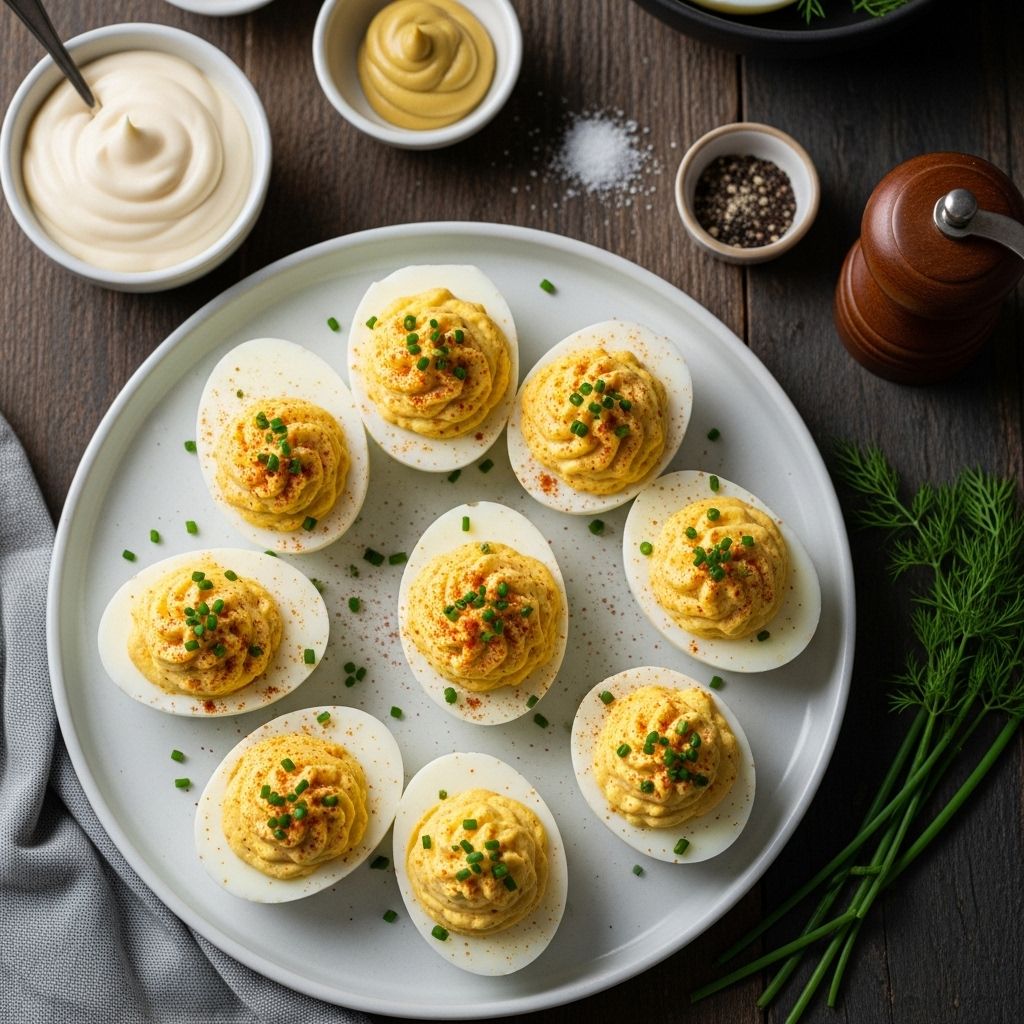Deviled Eggs Recipe: 5 Simple Ingredients
Elevate your gathering with these delicious, creamy stuffed eggs that are simple to prepare yet impressive to serve.

Image: HearthJunction Design Team
Classic Stuffed Eggs: A Timeless Appetizer
Stuffed eggs, often called deviled eggs in many circles, are one of those perfect appetizers that have stood the test of time. With their creamy, flavorful filling and protein-rich profile, these bite-sized treats are guaranteed to please crowds at any gathering. This classic recipe combines the richness of egg yolks with creamy mayonnaise, tangy Dijon mustard, and savory Parmesan cheese for a sophisticated yet simple appetizer that never goes out of style.
Whether you’re hosting a holiday dinner, planning a summer picnic, or just looking for a protein-packed snack, these stuffed eggs deliver both on flavor and presentation. The beauty of this recipe lies in its simplicity – with just a handful of ingredients and straightforward preparation, you can create an elegant appetizer that looks like you spent hours in the kitchen.
Ingredients You’ll Need
One of the best things about stuffed eggs is that they require minimal ingredients that you likely already have in your kitchen. Here’s everything you’ll need to make this classic recipe:
- 10 large eggs
- ¼ cup mayonnaise
- 1 teaspoon Dijon mustard
- 2 tablespoons grated Parmesan cheese
- Salt and ground black pepper to taste
The simplicity of these ingredients allows the natural flavor of the eggs to shine while providing a rich and creamy texture that makes stuffed eggs so irresistible. Feel free to use your favorite brand of mayonnaise, but full-fat versions typically yield the creamiest results. For the Dijon mustard, choose a good quality brand for the best flavor profile.
Equipment Required
Another advantage of making stuffed eggs is that you don’t need any specialized equipment. Here’s what you’ll need to have on hand:
- Medium or large pot for boiling eggs
- Bowl of ice water for cooling eggs
- Medium mixing bowl for preparing the filling
- Fork or potato masher for mashing the yolks
- Spoon for mixing the filling
- Teaspoon or piping bag for filling the egg whites (optional)
- Serving platter
While a piping bag with a decorative tip can create a more elegant presentation, it’s certainly not necessary. A simple spoon or teaspoon works perfectly well for filling the egg whites with your creamy yolk mixture.
Step-by-Step Instructions
Preparing the Perfect Hard-Boiled Eggs
The foundation of great stuffed eggs is properly cooked hard-boiled eggs. Follow these steps for eggs that are perfectly cooked with yolks that are set but still creamy:
- Place the 10 eggs in a medium or large pot and cover them with cold water, ensuring there’s about an inch of water above the eggs.
- Bring the water to a rolling boil over high heat.
- Once boiling, reduce the heat to maintain a gentle boil and cook the eggs for 10-12 minutes.
- While the eggs are cooking, prepare a bowl of ice water.
- When the eggs are done cooking, immediately transfer them to the ice water bath to stop the cooking process.
- Allow the eggs to cool completely in the ice water, about 10-15 minutes.
This method ensures that your eggs will be perfectly cooked and easy to peel, which is crucial for creating attractive stuffed eggs.
Peeling and Preparing the Eggs
Once your eggs are completely cooled, it’s time to peel and prepare them:
- Gently tap each egg on a hard surface to crack the shell all over.
- Peel the eggs under running water to help remove the shell cleanly.
- Pat the peeled eggs dry with paper towels.
- Using a sharp knife, carefully cut each egg in half lengthwise.
- Gently remove the yolks from each half and place them in a medium mixing bowl.
- Arrange the empty egg white halves on your serving platter.
For the cleanest cut, wipe your knife between eggs. If any of the egg whites tear during peeling, don’t worry – these can be your “taste test” eggs!
Creating the Creamy Filling
Now it’s time to transform those egg yolks into a delicious filling:
- Using a fork or potato masher, mash the egg yolks until they reach a fine, crumbly consistency.
- Add the ¼ cup of mayonnaise to the yolks and mix well until smooth.
- Stir in the teaspoon of Dijon mustard, which adds a subtle tanginess.
- Add the 2 tablespoons of grated Parmesan cheese, which brings a wonderful savory depth.
- Season with salt and ground black pepper to taste, being careful not to over-salt as the Parmesan already contains some saltiness.
- Mix all ingredients thoroughly until you achieve a smooth, creamy consistency.
The filling should be thick enough to hold its shape when spooned or piped into the egg whites but still creamy. If it seems too dry, you can add a bit more mayonnaise, a teaspoon at a time, until you reach the desired consistency.
Filling and Garnishing
The final step is to fill your egg white halves with the delicious yolk mixture:
- Using a teaspoon, small cookie scoop, or piping bag fitted with a star tip, fill each egg white half with a generous amount of the yolk mixture.
- If desired, sprinkle the tops with a light dusting of paprika for color and a subtle flavor enhancement.
- For an extra special touch, consider garnishing with small sprigs of fresh herbs like dill, chives, or parsley.
For the most elegant presentation, use a piping bag with a decorative tip to create beautiful swirls of filling in each egg half.
Serving and Storage Tips
Stuffed eggs are best served chilled and can be prepared in advance, making them perfect for entertaining. Here are some serving and storage tips to ensure your stuffed eggs are always at their best:
- Refrigerate completed stuffed eggs for at least 30 minutes before serving to allow the flavors to meld.
- Stuffed eggs can be prepared up to 24 hours in advance and stored in the refrigerator.
- For storage, place them in a single layer in an airtight container.
- If you need to prepare more than a day ahead, consider boiling and peeling the eggs, then storing the whites and prepared filling separately in airtight containers. Assemble just before serving.
- When transporting stuffed eggs to a gathering, use a specialized egg carrier or place them in a shallow container lined with paper towels to prevent sliding.
Remember that stuffed eggs should not be left at room temperature for more than 2 hours for food safety reasons.
Variations to Try
While this classic recipe is delicious as is, stuffed eggs are incredibly versatile and can be customized with countless flavor combinations. Here are some popular variations to consider:
- Bacon Lover’s: Add crumbled crispy bacon to the filling and as a garnish on top.
- Spicy: Mix in a dash of hot sauce or cayenne pepper for a kick.
- Herbed: Add finely chopped fresh herbs like dill, chives, or tarragon to the filling.
- Smoked Salmon: Incorporate small pieces of smoked salmon and a touch of cream cheese.
- Avocado: Replace some or all of the mayonnaise with ripe, mashed avocado.
- Pickle: Add finely chopped dill pickle or a splash of pickle juice to the filling.
Feel free to experiment with these variations or create your own signature stuffed eggs by adding ingredients that complement your menu or theme.
Nutritional Information
Stuffed eggs are not only delicious but also a nutritious choice for an appetizer. Each stuffed egg half provides a good source of protein along with essential vitamins and minerals. While the exact nutritional content will vary depending on specific ingredients used, here’s an approximate breakdown per stuffed egg half:
| Nutrient | Amount Per Serving |
|---|---|
| Calories | ~70-80 |
| Protein | ~3-4g |
| Fat | ~6g |
| Carbohydrates | ~1g |
| Cholesterol | ~110mg |
These protein-packed appetizers are relatively low in carbohydrates, making them suitable for many dietary preferences. If you’re watching your fat intake, consider using light mayonnaise as a substitution.
Frequently Asked Questions (FAQs)
Q: Why are my eggs difficult to peel?
A: Fresh eggs tend to be more difficult to peel. For easier peeling, use eggs that are at least a week old. Additionally, shocking the eggs in ice water immediately after boiling helps separate the membrane from the shell, making them easier to peel.
Q: Can I make stuffed eggs with soft-boiled eggs?
A: Traditional stuffed eggs require hard-boiled eggs so the whites maintain their shape and the yolks can be removed and mixed with other ingredients. Soft-boiled eggs would be too runny for this particular recipe.
Q: How far in advance can I make stuffed eggs?
A: You can make stuffed eggs up to 24 hours in advance. Store them in the refrigerator in an airtight container. For longer advance preparation, prepare the components separately and assemble just before serving.
Q: What’s the difference between stuffed eggs and deviled eggs?
A: The terms are often used interchangeably. Traditionally, “deviled” referred to dishes that were spiced or zesty, often with mustard, pepper, or other spicy ingredients. Stuffed eggs is a more general term that can encompass various fillings, though the classic preparation is very similar to deviled eggs.
Q: Can I freeze stuffed eggs?
A: Freezing is not recommended for stuffed eggs as the egg whites tend to become rubbery and the filling may separate upon thawing, resulting in an unpleasant texture.
Stuffed eggs remain one of the most popular and beloved appetizers for good reason. They’re simple to make, delicious to eat, and always a hit at gatherings. This classic recipe provides a wonderful foundation that you can enjoy as is or customize to your taste preferences. Whether you’re serving them at a holiday dinner, summer picnic, or casual get-together, these creamy, flavorful bites are sure to disappear quickly from your serving platter!
References
- https://www.allrecipes.com/recipe/257304/stuffed-eggs/
- https://www.allrecipes.com/recipe/222589/simple-deviled-eggs/
- https://www.allrecipes.com/recipe/16698/deviled-eggs-ii/
- https://www.allrecipes.com/recipe/223491/fully-loaded-deviled-eggs/
- https://www.allrecipes.com/million-dollar-deviled-eggs-recipe-8669008
Read full bio of Shinta












